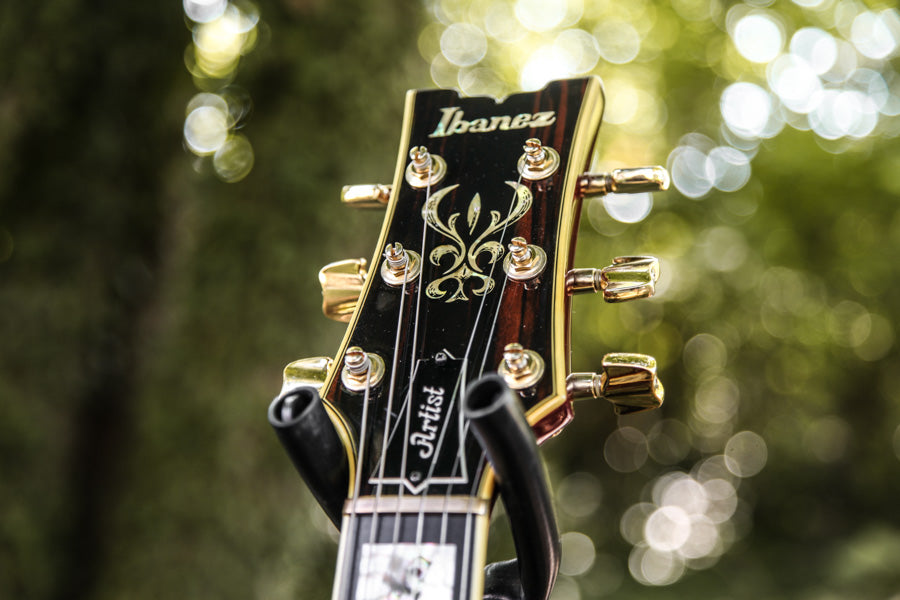Out Of The Case: 1983 Custom Shop Ibanez Artist
It’s 1983 and the Japanese are winning the export war, at least with regard to quality. Throughout the 1970s, America was stuck in an economic malaise that impacted the quality of its products: everything from cars to consumer electronics to—you guessed it—guitars. Gibson and Fender churned out, corporate style, mediocre products as did Ford and GM, and GE for that matter. Meanwhile, in the Land of the Rising Sun, the economy and quality products were burgeoning; Toyota lured US consumers with the promise of reliable transportation, and musical instrument makers like Yamaha and Ibanez (the latter brand name of Japan’s Hoshino corporation) stole sales from slumping the aforementioned American companies.
When it comes to guitars, there’s no greater example of high-quality Japanese workmanship and quality than the Ibanez brand (owned by the Hoshino company). Starting in the early ‘70s, it made the notorious “copy” guitars that were nearly identical to originals, such as the Ampeg Dan Armstrong plexiglass guitar, and various Gibson hollow-body and  semi-hollow guitars, but of a much higher quality. There were SG copies and Les Paul copies and the famous Flying V and Explorer replicants, the latter known as the Ibanez “Destroyer.” There was also copies of Fender Thinline Teles and Strats. The rub was that the Ibanez guitars were superb-playing guitars that often beat the originals into the ground.
semi-hollow guitars, but of a much higher quality. There were SG copies and Les Paul copies and the famous Flying V and Explorer replicants, the latter known as the Ibanez “Destroyer.” There was also copies of Fender Thinline Teles and Strats. The rub was that the Ibanez guitars were superb-playing guitars that often beat the originals into the ground.
Ibanez was hardly a one-trick pony, and the brand’s original designs are regarded today as truly outstanding guitars that were beautiful and meticulously built. In the late ‘70s and early ‘80s, the roster of star players began to grow, with George Benson getting a signature Ibanez guitar, and John Scofield opting to play an Ibanez semi-hollow rather than a Gibson. Around 1980, Bob Weir from the Grateful Dead began using a very ornate carved-top solidbody with a vine fretboard inlay and more abalone than can be harnessed from an ocean. Clearly, Ibanez was becoming a very major player in the American guitar market thanks to its reputation for quality and a growing list of endorsers.
One premier example of Ibanez greatness is this 1983 Custom Shop AR1500 model, here in a Cherry Sunburst finish (natural finish was also an option). The Artist solid-body series guitars began production in the mid ‘70s and by later that decade evolved into the model represented here. This guitar is built by the Ibanez Custom Shop—an elite group of builders separate from the regular production crew. It’s worth mentioning that even the regular production line builders were superb luthiers and the Hoshino factory required them to have certification (following coursework and assessment) toward that end. Back to the guitar; features are very similar to a Les Paul’s, with a multi-ply-bound maple top on a mahogany body. It veers away from that tradition with its three-piece mahogany/maple/mahogany neck and an ebony fretboard with elaborate three-piece abalone block position inlays and a headstock with even more abalone fanciness. Somehow, Japanese companies like Hoshino succeeded in combining high-end cosmetics onto these great guitars and still retailing for less than those famous American guitars.
like Hoshino succeeded in combining high-end cosmetics onto these great guitars and still retailing for less than those famous American guitars.
More about the guitar: pickups are highly regarded Ibanez Super 58 humbuckers that sound pretty close to the original PAFs: warm, underwound, and with great clarity and balance across the frequencies. Other features include a quick Change II tailpiece with a sustain plate and a tune-o-matic-like Gibralter II bridge. Tonally, it’s big, warm, and wooly-sounding with insane sustain for days. It can be very jazzy with the neck pickup, but activate the bridge pup and the AR1500 becomes a rock and roll beast. Unplugged, you can hear the guitar in another room. It’s one of the most solid of solid body guitars: stable and rugged. It’s the perfect example of how Japanese guitars were so great during the time of Ibanez’s ‘70s/’80s golden age, and remain that way today. In closing, the Ibanez AR1500 is big, it’s heavy, it’s wood (thank you Ren and Stimpy), and it’s a superb guitar.
Written By Mike Bieber
Photographs By Walter Bryant












